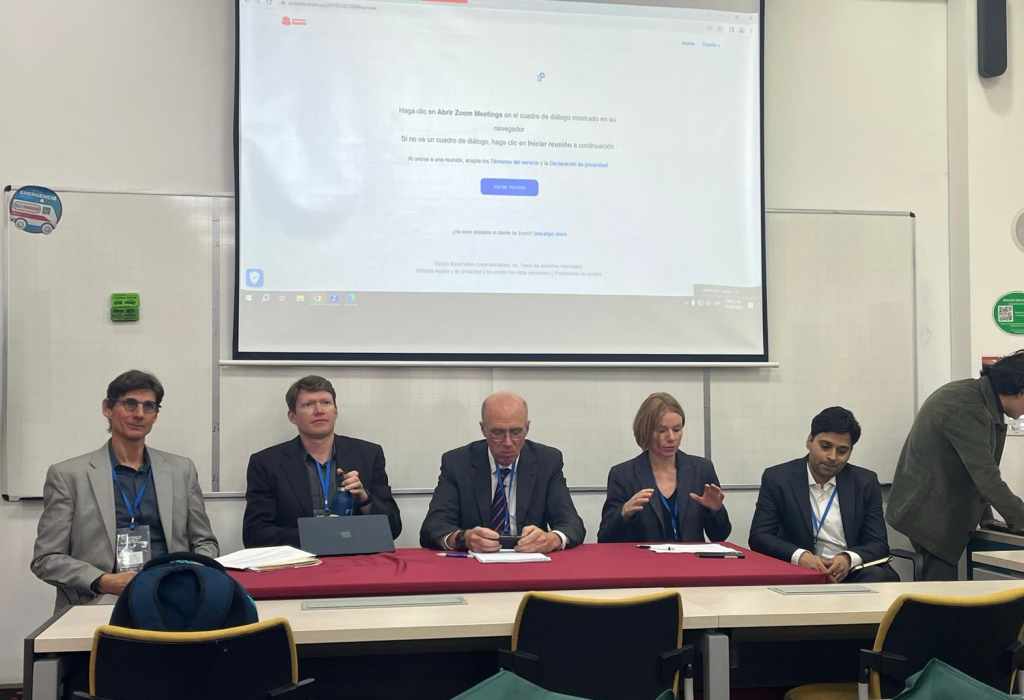The legal team of the Sinergia project «Making Trade Agreements Work in the Service of Society» was at the global conference of the Society of International Economic Law (SIEL) in Bogota from 12-14 July 2023 present with the Panel “Saving International Trade Agreements: The Potential of Package Treaties”. Panelists Rohan and Charlotte Sieber-Gasser from CTEI, Timothy Meyer from Duke University School of Law and Gregory Shaffer from Georgetown University presented preliminary findings from research conducted within the framework of the overall Sinergia project and the previous international workshop held in Geneva on 16 June 2023. Lothar Ehring from DG Trade led through the discussion.
Charlotte opened the discussion with a brief overview of different concepts in relation to trade liberalization packages developed within the framework of the Sinergia project. Most importantly, the research project looks into ways how to mitigate or even prevent negative effects of trade liberalization. Such negative effects can take place at home, abroad or in a third country. Furthermore, negative effects of trade liberalization can be divided into necessary negative effects (individual income losses which are needed for the benefits of trade to materialize) and incidental negative effects (e.g. environmental pollution or exploitation of labor exacerbated through trade). Flanking policies (measures specifically linked to trade liberalization) and mitigating policies (general measures suitable to address negative effects of trade liberalization) address these negative effects of trade liberalization. The project is interested in exploring flanking measures, especially if they are part of the same legal instrument which also liberalizes trade – i.e. “trade liberalization packages” or “package treaties”.
In his introductory remarks, Gregory emphasized the need to retool trade policy and agreements to address negative externalities. The traditional model of addressing negative externalities consists of two steps: 1) international trade deals supported by domestic social welfare policies, and 2) authorized protection in the form of anti-dumping duties and countervailing duties. However, this model is under challenge with developments such as the shift in bargaining power of capital vis-a-vis labor, the rise of China, climate change risks etc. These trends call for a re-think in the form of trade liberalization packages: hard law instruments (USMCA) and soft law instruments (IPEF) need to be considered, along with innovative ideas such as linking of TAA with trade agreements, extending anti-dumping policies to social dumping, or raising resources to fund different flanking policies eg. through taxes.
Timothy continued by elaborating on the conceptual framework of flanking policies by classifying them into first- and second-generation flanking. The first-generation flanking policies focus on targeting domestic losses which are economic in nature and caused by trade liberalization eg. TAA. The second-generation flanking policies target foreign non-economic costs of trade liberalization eg. CBAM (EU). They employ trade-distorting policies such as tariffs, taxes and import bans, whereas first-generation flanking policies mainly used domestic subsidies. Also, they respond to extraterritorial, non-economic externalities linked with trade liberalization which reflects a significant re-orientation of jurisdictional limits in international trade law.
Given the many emerging flanking initiatives worldwide, Charlotte looked into their connection with collective action problems. While trade liberalization packages appear ideally suited to address long-standing, urgent collective action problems linked with international economic law (such as climate change mitigation, or the protection of biodiversity), existing trade liberalization packages are not specifically designed to overcome these. If anything, they work towards establishing binding global minimum standards in the protection of biodiversity and in labor standards. This in itself does, however, not create the necessary incentives and leverages to overcome collective action problems – nor do trade liberalization packages systematically address climate change mitigation (yet).
Rohan then steered the discussion in the direction of developing economies to highlight the impact of regulatory challenges on the choice of flanking policies. He applied the conceptual framework in a specific case-study on India and emphasized that the informal nature of the labor market creates design and implementation challenges in relation to labor market adjustment policies. These limitations reduce the policy space available for the government when addressing the concerns of domestic workers. To address the regulatory gaps in the domestic labor market and create additional policy space, trade liberalization packages can play an important role in terms of pushing domestic reforms, bridging resource gaps, and creating incentives through links between domestic policies and commitments within trade agreements.
The ensuing discussion with Lothar and the audience was most productive. We look forward to finalizing the respective draft papers and continue the discussion.
Photo Credit: Tetyana Payosova




